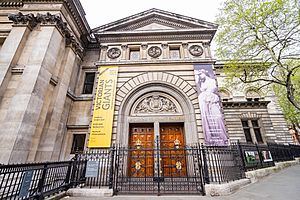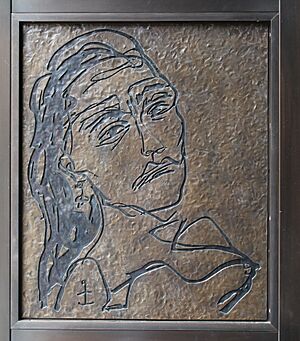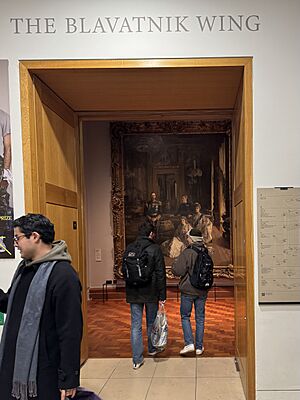National Portrait Gallery, London facts for kids
 |
|
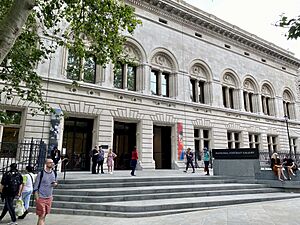
The main entrance in June 2023
|
|
| Established | 1856 |
|---|---|
| Location | St Martin's Place, London, WC2H 0HE, United Kingdom |
| Collection size | 195,000 portraits |
| Visitors | 1,619,694 (2019)
|
| Public transit access | |
The National Portrait Gallery (often called NPG) is a special art gallery in London. It holds a huge collection of portraits of famous and important British people from history. When it first opened in 1856, it was one of the very first public galleries in the world just for portraits!
The gallery moved to its current home in 1896. You can find it at St Martin's Place, right next to Trafalgar Square and the National Gallery. The National Portrait Gallery also has smaller locations in other parts of the UK. These are at Beningbrough Hall in Yorkshire and Montacute House in Somerset. It is a separate place from the Scottish National Portrait Gallery in Edinburgh. The gallery is supported by the UK government.
Contents
Discovering the Collection
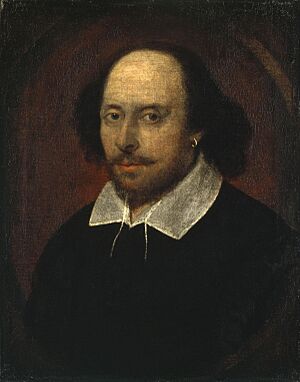
The gallery is filled with portraits of important and famous British people. The main idea is to show how important the person in the picture was, not always how famous the artist was. The collection includes many different types of art. You can see photographs, funny drawings called caricatures, paintings, sketches, and even sculptures.
One of the most famous pictures here is the Chandos portrait. Many believe it shows the famous writer William Shakespeare. However, some people are not completely sure if it's really him.
While not every portrait is a masterpiece, many are very special. You can see self-portraits by famous British artists like William Hogarth and Sir Joshua Reynolds. Some portraits are like historical documents. For example, a group picture from the Somerset House Conference of 1604 tells us a lot about that time.
Sometimes, the story behind a portrait is more interesting than the art itself. This is true for the unusual portrait of Edward VI by William Scrots. Or the painting of the Brontë sisters (Charlotte, Emily, and Anne) by their brother, Branwell. There's also a sculpture of Queen Victoria and Prince Albert dressed in medieval clothes.
Since 1969, the gallery has also shown portraits of people who are still alive. Besides its main collection, the NPG often displays new art. It also hosts special shows by different artists. Plus, it holds the yearly BP Portrait Prize competition, which is a big deal for portrait artists.
Gallery History and Buildings
Three important people helped start the National Portrait Gallery. You can see their stone busts above the old main entrance. In the middle is Philip Henry Stanhope, 4th Earl Stanhope. On either side are his friends, Thomas Babington Macaulay, 1st Baron Macaulay, and Thomas Carlyle.
It was Stanhope who first suggested the idea of a National Portrait Gallery in 1846. After trying a third time in 1856, his idea was finally accepted. Queen Victoria agreed, and the government set aside money to create the gallery. Important people like Benjamin Disraeli also helped. Lord Ellesmere gave the gallery its very first portrait, the famous Chandos portrait.
For its first 40 years, the gallery moved around London. It started in Westminster, then moved to Exhibition Road, and later to the Bethnal Green Museum. These places were not perfect. Eventually, a kind person named William Henry Alexander gave a lot of money to build a new, permanent home. The government also provided land next to the National Gallery. The new building opened on April 4, 1896.
Modern Changes and Reopening

In 2000, the Ondaatje Wing opened. This new part of the gallery has a huge escalator. It takes visitors up to see some of the oldest portraits, from the Tudor period.
In 2012, Catherine, Duchess of Cambridge (now the Princess of Wales), became a special supporter of the gallery. Her own portrait was shown there in 2013.
From 2020 to 2023, the gallery closed for a big makeover called "Inspiring People." During this time, some portraits traveled to other museums around the UK and even to other countries. The project aimed to completely update the building. It created new public spaces and a more welcoming entrance. The East Wing, which used to be offices, became new gallery space with its own entrance.
The refurbishment cost £41 million. It added new galleries, learning areas, and restaurants. The main entrance was moved, and it now has three new bronze doors. These doors feature 45 portraits of unnamed women, drawn by the artist Tracey Emin.
In 2022, the gallery received a very generous gift of £10 million from the Blavatnik Family Foundation. This money helped create the new Blavatnik Wing. This wing on the first floor shows over a hundred years of British portraits.
The gallery officially reopened on June 20, 2023, with the Princess of Wales attending. She met Sir Paul McCartney, whose photography exhibition was the first big show in the new space. The gallery opened to the public two days later, on June 22.
Exterior Busts
Outside the original 1896 buildings, you can see stone busts of famous artists, writers, and historians. These sculptures were made by Frederick R. Thomas. They show people like James Granger, William Hogarth, Sir Joshua Reynolds, and Sir Thomas Lawrence. These individuals were important in the world of art and history.
How the Gallery is Run
The National Portrait Gallery is a special public body of the UK Government. This means it gets support from the Department for Digital, Culture, Media and Sport. It is also a charity, which helps it continue its important work.
See also
 In Spanish: National Portrait Gallery para niños
In Spanish: National Portrait Gallery para niños
- BP Portrait Award
- British Photographic Portrait Prize
- Royal Society of Portrait Painters


